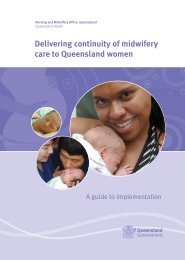Mater Misericordiae Hospital Gladstone - Queensland Centre for ...
Mater Misericordiae Hospital Gladstone - Queensland Centre for ...
Mater Misericordiae Hospital Gladstone - Queensland Centre for ...
You also want an ePaper? Increase the reach of your titles
YUMPU automatically turns print PDFs into web optimized ePapers that Google loves.
IntroductionBackgroundThe <strong>Queensland</strong> <strong>Centre</strong> <strong>for</strong> Mothers & Babies (QCMB) is an independent research centre based at The University of <strong>Queensland</strong>.The <strong>Centre</strong> was funded by the <strong>Queensland</strong> Government in 2009, in response to the findings of the Review of <strong>Mater</strong>nity Servicesin <strong>Queensland</strong> (Hirst, 2005). A key strategic direction of the <strong>Centre</strong> is to generate and disseminate evidence that enhances thecapacity of care providers and policy-makers to understand, and respond to, the requirements of women accessing maternitycare.To meet this goal, the QCMB conducts population surveys to understand the maternity care experiences of women in<strong>Queensland</strong>. The surveys ask women about the care and support they received be<strong>for</strong>e, during and after the birth of their mostrecent baby. The surveys are an important way of collecting women’s perspectives on the quality of maternity services providedin <strong>Queensland</strong>.The 2010 Having a Baby in <strong>Queensland</strong> SurveyIn 2010, all women who had a live birth in <strong>Queensland</strong> between February 1 and May 30, received a Having a Baby in <strong>Queensland</strong>Survey package in the mail when their baby was 4 to 5 months old. Three modes of survey completion were available to women:paper, online or telephone. Women were also given the option to complete the survey in a language other than English over thetelephone, with a translator and a female interviewer (see Miller et al., 2011 <strong>for</strong> more in<strong>for</strong>mation).Data collected in the Having a Baby in <strong>Queensland</strong> Survey Program are used in several ways. Data are provided directly to<strong>Queensland</strong> Health in a comprehensive report outlining key survey findings. This report highlights differences in consumerexperiences based on health sector, parity, and rurality of residence, in addition to providing recommendations <strong>for</strong> improvedservice delivery. An electronic copy of the report is available at www.qcmb.org.au/reports. Data are also presented in Birthplace,an online consumer guide to all birthing facilities in <strong>Queensland</strong> (www.havingababy.org.au/birthplace) 1 . Birthplace was developedto support women and their families to choose a facility <strong>for</strong> birth and/or to know what to expect from their chosen birthing facility.Birthplace can also be used by care providers and others <strong>for</strong> quality improvement purposes, and some facility-level data notincluded in this report can be viewed in Birthplace.About This ReportThis report presents the findings of the 2010 Having a Baby in <strong>Queensland</strong> Survey at an individual facility level. The report wasdeveloped as a means of providing feedback on the experiences of consumers to facilities, particularly by identifying areas ofstrength and opportunities <strong>for</strong> improvement in service delivery. We have selected 22 key per<strong>for</strong>mance indicators to highlight thecare provided to women in each geographic region in <strong>Queensland</strong>. Rather than reporting on clinical indicators that may differaccording to the case mix in a particular facility, indicators were selected based on their applicability to all women.On each per<strong>for</strong>mance indicator we provide the proportion of respondents from each birth facility within that region who reportedreceiving ‘gold standard care’. Gold standard care is always represented by the red bars in the graph. For some indicators (e.g.being well cared <strong>for</strong>, being treated with respect), gold standard care is achieved where women give their care the highestevaluation possible. Where data are measured on a continuous scale of 1 (lowest) to 5 (highest), gold standard care is achieved<strong>for</strong> all women who report ‘5’. Where data are measured as a proportion of time (e.g. ‘none of the time’, ‘some of the time’, ‘all ofthe time’), gold standard care is achieved <strong>for</strong> all women who report ‘all of the time’. We report on gold standard care as it isexpected that care providers would strive <strong>for</strong> all women in the birth facility to receive the highest level of care possible <strong>for</strong> suchindicators.For other indicators (e.g. timing of booking visit, postnatal contact), gold standard care is achieved where women report anexperience that is consistent with current <strong>Queensland</strong> Health policies and guidelines and/or research evidence on best carepractices. Again, we report on gold standard care as it is expected that care providers would strive <strong>for</strong> all women in the birthfacility to report care consistent with current policies, guidelines and research evidence.1In some instances, the figures presented in this report may differ by 1% from those reported in Birthplace due to differential approaches <strong>for</strong>rounding decimal places between the two systems.6
















